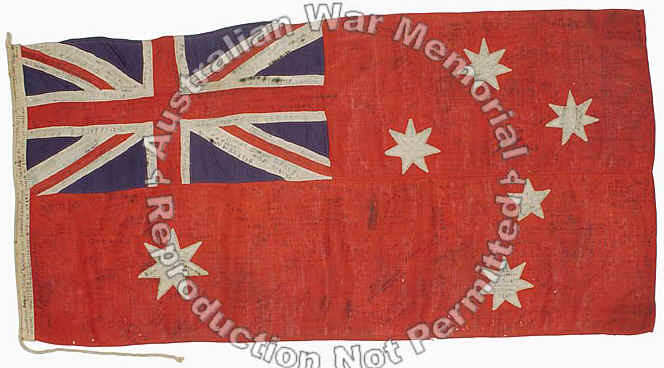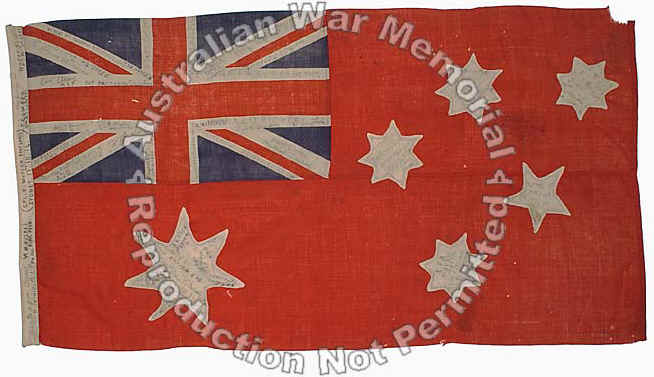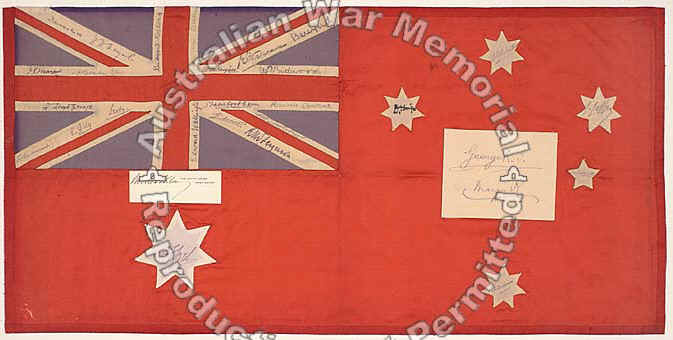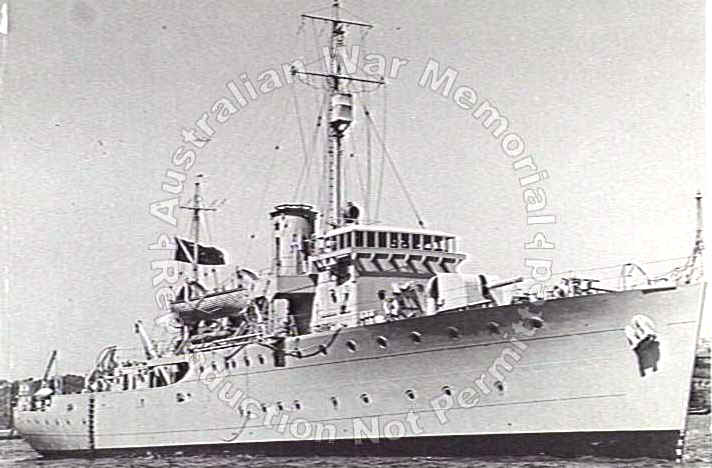|
|

|
Title: Autographed
Australian red ensign carried by NX17521 Corporal W E Watson as a POW in
Greece, and later in New Guinea Maker: S Calder Ltd, Sydney Object type:
Flag Place made: Sydney Date made: 1939 Physical description: Wool
bunting; canvas; hemp Summary: NX17521 Corporal William Edward Watson
served with 6 Division AAOC and 7 Division Provost Company. He was
captured on Crete on 1 June 1941, shipped to Athens and then Salonika.
He escaped from Salonika on 29 June 1941, joined up with other POW
escapees and hid in the Greek mountains until 1942, when he successfully
escaped by boat to Turkey on 5 May 1942. Watson was discharged medically
unfit on his return to Australia and subsequently joined the American
Small Boats Division, serving in New Guinea. He was awarded the Military
Medal for 'courage and perseverance in escapes from POW camps'.
In 1914, Watson's father, who had served with a British Regiment before
emigrating to Australia, was farewelled by the Australian Attorney
General W M 'Billy' Hughes (later Prime Minister) as he returned to
Britain with other Imperial Reservists for service in the First World
War. Hughes presented Watson with an Australian red ensign which he
carried with him throughout the war. Watson claimed that it was the
first Australian flag to be flown in France during the war, and on his
safe return to Australia presented it to the Australian War Museum
(later War Memorial) for display. His son, W E Watson, asked that the
flag be returned to him to carry during his service in the Second World
War, but his request was refused. Watson then applied to Billy Hughes,
who was again Attorney General, for another flag, and this red ensign is
the one that Hughes sent to him, together with the words, 'I would like
to say that it is my earnest prayer that you will be spared to carry it
triumphantly throughout this present conflict. You will bear it through
lands where the valorous tradition of the A.I.F. is a by-word. I know
that this glorious heritage will be safe in the keeping of Australia's
sons of the 2nd A.I.F.'. Watson junior carried it throughout his service
in Egypt, concealed it during his captivity in Crete and Greece, and
again carried it during his service in New Guinea |
|

|
This ensign was presented
to the Imperial Reservists who left Australia in 1914, by the Honourable
W M 'Billy' Hughes, then Attorney General and later Prime Minister, and
personally handed to Corporal Edward Dawson Watson of the East
Lancashire Regiment. The Imperial Reservists were men who had recently
served with a British Regiment before emigrating to Australia. On the
outbreak of the First World War they were recalled to serve with their
old units and sailed in the first troop convoy to leave Australia.
Dawson took the flag to England and France, and carried it during the
retreat from Mons. After a spell in England he took it back to France in
March 1917. Watson remained in France until the German Advance in March
1918, when he was wounded. He brought the flag back to Australia in
1919. Watson claimed that it was the was the first Australian flag to
fly in France during the First World War, however the NSW Volunteer
Ambulance Unit may also have carried one in France in 1914.
Watson presented the flag to the Australian War Museum (later War
Memorial) in 1925 on the condition that it be returned to him for each
year's Anzac Day march. He died shortly after Anzac Day in 1934 and the
flag has been part of the Memorial's permanent collection since this
date. |
|

|
William Pearson Tewksbury,
a successful Melbourne businessman, conceived the idea of raising funds
for wounded Australian soldiers by raffling a flag autographed by the
world's most famous men, including national and war leaders, Field
Marshal Lord Kitchener, Prime Minister W M Hughes and General Monash.
The flag was sent around the world to obtain the signatures and 20,000
pounds was raised from the raffle. The flag was advertised as the
'Kitchener Flag'. It was won by a retired seaman who sold it to Edward
Solomon, a Melbourne philanthropist and collector, who had already
purchased other autographed flags at fund raising auctions for the war
effort. Solomon later presented his entire autographed flag collection,
which he had acquired during the First World War, to the Australian War
Memorial.
During the Second World War William Tewkesbury again raised funds for
wounded soldiers by raffling an autographed flag known as the 'Churchill
Flag', this time raising 28,000 pounds.
|
|

|
| Framed moulded-paper
bulldog mascot superimposed on an Australian red ensign : Private P J
Bradshaw, 6 Battalion, AIF.
Associated with 713 Private Percival
James Bradshaw, 6 Battalion AIF. He enlisted on 24 February 1917, served
on the Western Front, and returned to Australia on 13 July 1919. He
acquired the mascot from the battalion sergeants' mess when he was an
orderly. |
|

|
| PORT PHILLIP BAY, VIC.
1953. STARBOARD BEAM VIEW OF THE FORMER DESTROYER HMAS QUADRANT (FO1)
AFTER HER CONVERSION TO AN ANTI SUBMARINE FRIGATE. EXTERNALLY HER
DESTROYER ORIGINS ARE INDICATED ONLY BY HER FUNNEL AND HULL AS ALL
SUPERSTRUCTURE ABOVE THE UPPER DECK HAS BEEN REPLACED. THE SHIP'S NEW
ARMAMENT CONSISTS OF A TWIN 40 MM BOFORS MARK 5 AA MOUNTING FORWARD AND
4 INCH MARK 16 GUNS IN A TWIN MARK 19 MOUNTING AFT. NOTE THE LAUNCHING
RAILS FOR FLARE ROCKETS FITTED TO THE SIDE OF THE MOUNTING. THE GUNS ARE
CONTROLLED BY THE CLOSE RANGE BLIND FIRE DIRECTOR SITED JUST FORWARD OF
THE 4 INCH MOUNTING. A SQUID ANTI SUBMARINE MORTAR IS FITTED AFT AND IS
A DISTINGUISHING FEATURE OF THIS VESSEL, THE REMAINDER OF THE CLASS
HAVING THE LONGER BARRELLED LIMBO. A TYPE 277 HEIGHT FINDING RADAR IS
FITTED JUST ABOVE THE BRIDGE. TYPE 293Q AIR SURFACE SEARCH AND TYPE 974
NAVIGATION RADARS ARE FITTED TO THE FOREMAST. THE
SHIP HAS NOT YET BEEN COMMISSIONED AND IS FLYING THE RED ENSIGN.
SHE IS ALSO NOT FULLY FITTED OUT, MISSING HER MAINMAST. (NAVAL
HISTORICAL COLLECTION) |
 |
| SYDNEY, NSW. 1941-09.
STARBOARD BOW VIEW OF THE CORVETTE HMAS WARRNAMBOOL. SHE IS NOT YET
COMMISSIONED AND CONSEQUENTLY
FLIES THE RED ENSIGN. SHE IS ARMED
WITH A 4 INCH BL MARK IX GUN ON A CP I MOUNTING FORWARD. NO CLOSE RANGE ARMAMENT
HAS YET BEEN FITTED. NOTE THE KITE/OTTERS AND FLOATS OF HER OROPESA
MINESWEEPING EQUIPMENT ON THE STERN. (NAVAL HISTORICAL COLLECTION |
|
|
|